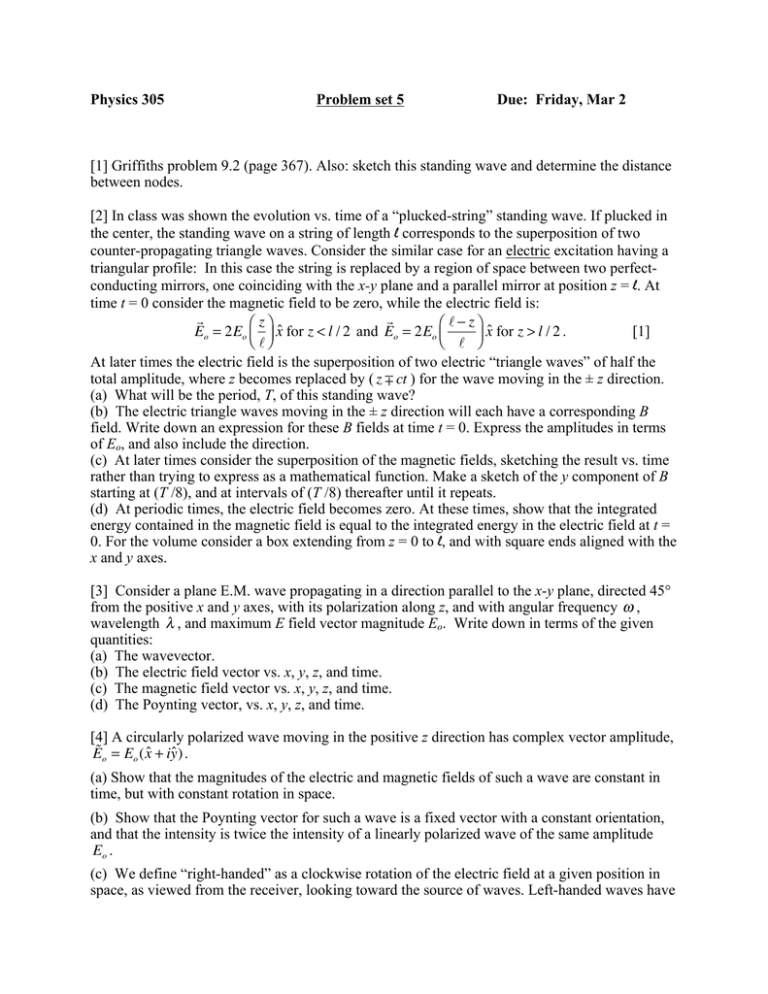Physics 305 Problem set 5 Due: Friday, Mar 2
advertisement

Physics 305 Problem set 5 Due: Friday, Mar 2 [1] Griffiths problem 9.2 (page 367). Also: sketch this standing wave and determine the distance between nodes. [2] In class was shown the evolution vs. time of a “plucked-string” standing wave. If plucked in the center, the standing wave on a string of length l corresponds to the superposition of two counter-propagating triangle waves. Consider the similar case for an electric excitation having a triangular profile: In this case the string is replaced by a region of space between two perfectconducting mirrors, one coinciding with the x-y plane and a parallel mirror at position z = l. At time t = 0 consider the magnetic field to be zero, while the electric field is: ! ! ! z$ " " ! z% Eo = 2Eo # & x̂ for z < l / 2 and Eo = 2Eo $ x̂ for z > l / 2 . [1] " "% # " '& At later times the electric field is the superposition of two electric “triangle waves” of half the total amplitude, where z becomes replaced by ( z ! ct ) for the wave moving in the ± z direction. (a) What will be the period, T, of this standing wave? (b) The electric triangle waves moving in the ± z direction will each have a corresponding B field. Write down an expression for these B fields at time t = 0. Express the amplitudes in terms of Eo, and also include the direction. (c) At later times consider the superposition of the magnetic fields, sketching the result vs. time rather than trying to express as a mathematical function. Make a sketch of the y component of B starting at (T /8), and at intervals of (T /8) thereafter until it repeats. (d) At periodic times, the electric field becomes zero. At these times, show that the integrated energy contained in the magnetic field is equal to the integrated energy in the electric field at t = 0. For the volume consider a box extending from z = 0 to l, and with square ends aligned with the x and y axes. [3] Consider a plane E.M. wave propagating in a direction parallel to the x-y plane, directed 45° from the positive x and y axes, with its polarization along z, and with angular frequency ! , wavelength ! , and maximum E field vector magnitude Eo. Write down in terms of the given quantities: (a) The wavevector. (b) The electric field vector vs. x, y, z, and time. (c) The magnetic field vector vs. x, y, z, and time. (d) The Poynting vector, vs. x, y, z, and time. [4] A circularly polarized wave moving in the positive z direction has complex vector amplitude, E! o = Eo ( x̂ + iŷ) . (a) Show that the magnitudes of the electric and magnetic fields of such a wave are constant in time, but with constant rotation in space. (b) Show that the Poynting vector for such a wave is a fixed vector with a constant orientation, and that the intensity is twice the intensity of a linearly polarized wave of the same amplitude Eo . (c) We define “right-handed” as a clockwise rotation of the electric field at a given position in space, as viewed from the receiver, looking toward the source of waves. Left-handed waves have a counter-clockwise rotation from such a viewpoint. Is the wave defined above right-handed or left-handed? (d) Show that the superposition of left and right circularly polarized waves, traveling in the same direction and with equal amplitudes and frequencies, gives a linearly polarized wave. [5] (a) For reflection of normal-incidence plane waves from a “perfect conductor” surface, show that the electric field outside of the conductor is a standing wave, with plane nodes (positions where the field is zero at all times) located at the conductor surface and at parallel positions every half-wavelength. Show also that the magnetic field makes a standing wave, but shifted by ¼ wavelength. (b) For normal-incidence reflection from a dielectric, consider the case where light is incident from vacuum onto a transparent dielectric (n > 1). On the vacuum side, show that the incident + reflected light does not make a complete standing wave; there are local maxima and minima of the oscillating E field. Find the “standing wave ratio”, which is the ratio of the maximum E field amplitude to the minimum E field amplitude. (In other words, measuring at a fixed position z, the field oscillates vs. time; but the amplitude depends on z; look for the maximum and minimum local amplitude values and take the ratio.) [6] Griffiths problem 9.33 (page 412).






